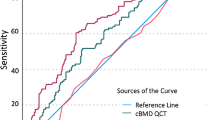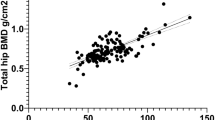Abstract
Summary
Osteoporotic fracture risk depends on bone mineral density (BMD) and clinical risk factors (CRF). Five hundred and eighty-eight untreated female and male outpatient subjects were evaluated, 160 with vertebral fractures. BMD was measured both by using calcaneal dual X-ray and laser (DXL) and dual-energy X-ray absorptiometry (DXA), and CRF were evaluated. Detection frequencies for different BMD methods with or without CRF are presented.
Introduction
Osteoporotic fracture risk depends on bone mineral density and clinical risk factors. DXA of the spine/hip is considered a gold standard for BMD assessment, but due to degenerative conditions, particularly among the older population, assessment of BMD at the lumbar spine has been shown to be of limited significance. Portable calcaneal dual X-ray technology and laser can be an easily obtainable alternative.
Methods
Vertebral fractures were evaluated in a baseline analysis of 588 females and males (median age 64.4, range 17.6–93.1 years), comparing BMD measurements by using DXL and DXA and CRF with/without BMD. One hundred and sixty subjects had radiological verified vertebral fractures. Area under receiver-operating characteristic curves (AUROCC) and univariate and multiple logistic regressions were calculated.
Results
AUROCC for detection of vertebral fractures was comparable for DXL at calcaneus and DXA at femoral neck (DXL 0.665 and DXA 0.670). Odds ratio for prevalent vertebral fracture was generally weak for DXA femoral neck (0.613) and DXL (0.521). Univariate logistic regression among CRF without BMD revealed age, prevalent fragility fracture, and body mass index significantly associated with prevalent vertebral fracture (AUROCC = 0.805). Combining BMD and CRF, a prognostic improvement in case of DXA at femoral neck (AUROCC 0.869, p = 0.02), DXL at calcaneus (AUROCC 0.869, p = 0.059), and DXA at total hip (AUROCC 0.861, p = 0.06) was observed.
Conclusions
DXL was similarly sensitive compared with DXA for identification of subjects with vertebral fragility fractures, and combination of CRF with BMD by DXL or DXA further increased the discriminatory capacity for detection of patients susceptible to vertebral fracture.



Similar content being viewed by others
References
World Health Organization (1994) Assessment of fracture risk and its application to screening for postmenopausal osteoporosis. Report of a WHO Study Group, Geneva. Tech Rep Ser 843:1–129
Bliuc D, Nguyen ND, Milch VE, Nguyen TV, Eisman JA, Center JR (2009) Mortality risk associated with low-trauma osteoporotic fracture and subsequent fracture in men and women. JAMA 301:513–521. doi:10.1001/jama.2009.50
Cameron ID, Chen JS, March LM, Simpson JM, Cumming RG, Seibel MJ et al (2010) Hip fracture causes excess mortality owing to cardiovascular and infectious disease in institutionalized older people: a prospective 5-year study. J Bone Miner Res 25:866–872. doi:10.1359/jbmr.091029
United States Department of Health and Human Services (2004) Bone health and osteoporosis: a report of the surgeon general. Office of the Surgeon General. Rockville, MD
Reginster JY, Burlet N (2006) Osteoporosis: a still increasing prevalence. Bone 38(Suppl 1):S4–9. doi:10.1016/j.bone.2005.11.024
Delmas PD, van de Langerijt L, Watts NB, Eastell R, Genant H, Grauer A, Cahall DL; IMPACT Study Group (2005) Underdiagnosis of vertebral fractures is a worldwide problem: the IMPACT study. J Bone Miner Res 20:557–563. doi:10.1359/jbmr.041214
Hasserius R, Karlsson MK, Jónsson B, Redlund-Johnell I, Johnell O (2005) Long-term morbidity and mortality after a clinically diagnosed vertebral fracture in the elderly—a 12- and 22-year follow-up of 257 patients. Calcif Tissue Int 76:235–242. doi:10.1007/s00223-004-2222-2
Hasserius R, Karlsson MK, Nilsson BE, Redlund-Johnell I, Johnell O; European Vertebral Osteoporosis Study (2003) Prevalent vertebral deformities predict increased mortality and increased fracture rate in both men and women: a 10-year population-based study of 598 individuals from the Swedish cohort in the European Vertebral Osteoporosis Study. Osteoporos Int 14:61–68. doi:10.1007/s00198-002-1316-9
Ismail AA, Pye SR, Cockerill WC, Lunt M, Silman AJ, Reeve J et al (2002) Incidence of limb fracture across Europe: results from the European Prospective Osteoporosis Study (EPOS). Osteoporos Int 13:565–571. doi:10.1007/s001980200074
Cummings SR, Nevitt MC, Browner WS, Stone K, Fox KM, Ensrud KE, Cauley J, Black D, Vogt TM (1995) Risk factors for hip fracture in white women. Study of Osteoporotic Fractures Research Group. N Engl J Med 332:767–773. doi:10.1056/NEJM199503233321202
Schott AM, Cormier C, Hans D, Favier F, Hausherr E, Dargent-Molina P, Delmas PD, Ribot C, Sebert JL, Breart G, Meunier PJ (1998) How hip and whole-body bone mineral density predict hip fracture in elderly women: the EPIDOS Prospective Study. Osteoporos Int 8:247–254
Kanis J (2002) Diagnosis of osteoporosis and assessment of fracture risk. Lancet 359:1929–1936. doi:10.1016/S0140-6736(02)08761-5
Khaw KT, Reeve J, Luben R, Bingham S, Welch A, Wareham N, Oakes S, Day N (2004) Prediction of total and hip fracture risk in men and women by quantitative ultrasound of the calcaneus: EPIC-Norfolk prospective population study. Lancet 363:197–202. doi:10.1016/S0140-6736(03)15325-1
Kullenberg R, Hanson B, Sandberg R, Dahlberg H (2006) Comprehensive osteoporosis management with easy access to bone mineral density measurements. J Eval Clin Pract 12:675–681. doi:10.1111/j.1365-2753.2006.00635.x
Black DM, Cummings SR, Genant HK, Nevitt MC, Palermo L, Browner W (1992) Axial and appendicular bone density predict fractures in older women. J Bone Miner Res 7:633–638. doi:10.1002/jbmr.5650070607
Cummings SR, Black DM, Nevitt MC, Browner W, Cauley J, Ensrud K, Genant HK, Palermo L, Scott J, Vogt TM (1993) Bone density at various sites for prediction of hip fractures. The Study of Osteoporotic Fractures Research Group. Lancet 341:72–75
Swanpalmer J, Kullenberg R (2000) A new measuring device for quantifying the amount of mineral in the heel bone. Ann N Y Acad Sci 904:115–117
Hakulinen MA, Saarakkala S, Töyräs J, Kröger H, Jurvelin JS (2003) Dual energy x-ray laser measurement of calcaneal bone mineral density. Phys Med Biol 48:1741–1752
Kullenberg R, Falch JA (2003) Prevalence of osteoporosis using bone mineral measurements at the calcaneus by dual X-ray and laser (DXL). Osteoporos Int 14:823–827. doi:10.1007/s00198-003-1442-z
Thorpe JA, Steel SA (2006) The DXL Calscan heel densitometer: evaluation and diagnostic thresholds. Br J Radiol 79:336–341. doi:10.1259/bjr/22191429
Söderpalm AC, Kullenberg R, Swolin-Eide D (2008) The relationship between dual energy X-ray absorptiometry (DXA) and DXA with laser (DXL) measurements in children. J Clin Densitom 11:555–560. doi:10.1016/j.jocd.2008.06.003
Johnell O, Gullberg B, Kanis JA, Allander E, Elffors L, Dequeker J, Dilsen G, Gennari C, Lopes Vaz A, Lyritis G et al (1995) Risk factors for hip fracture in European women: the MEDOS Study. Mediterranean Osteoporosis Study. J Bone Miner Res 10:1802–1815. doi:10.1002/jbmr.5650101125
Kanis JA, Johnell O, De Laet C, Johansson H, Oden A, Delmas P, Eisman J, Fujiwara S, Garnero P, Kroger H, McCloskey EV, Mellstrom D, Melton LJ, Pols H, Reeve J, Silman A, Tenenhouse A (2004) A meta-analysis of previous fracture and subsequent fracture risk. Bone 35:375–382. doi:10.1016/j.bone.2004.03.024
Kanis JA, Johnell O, Oden A, Johansson H, McCloskey E (2008) FRAX® and the assessment of fracture probability in men and women from the UK. Osteoporos Int 19:385–397. doi:10.1007/s00198-007-0543-5
Genant HK, Wu CY, van Kuijk C, Nevitt MC (1993) Vertebral fracture assessment using a semiquantitative technique. J Bone Miner Res 8:1137–1148. doi:10.1002/jbmr.5650080915
Hind K, Oldroyd B, Truscott JG (2010) In vivo precision of the GE Lunar iDXA® densitometer for the measurement of total-body, lumbar spine, and femoral bone mineral density in adults. J Clin Densitom 13:413–417. doi:10.1016/j.jocd.2010.06.002
Hind K, Oldroyd B, Prajapati A, Rhodes L (2012) In vivo precision of dual-energy X-ray absorptiometry-derived hip structural analysis in adults. J Clin Densitom 15:302–307. doi:10.1016/j.jocd.2011.12.004
Kullenberg R (2003) Reference database for dual X-ray and laser Calscan bone densitometer. J Clin Densitom 6:367–372
De Laet C, Kanis JA, Odén A, Johanson H, Johnell O, Delmas P, Eisman JA, Kroger H, Fujiwara S, Garnero P, McCloskey EV, Mellstrom D, Melton LJ 3rd, Meunier PJ, Pols HA, Reeve J, Silman A, Tenenhouse A (2005) Body mass index as a predictor of fracture risk: a meta-analysis. Osteoporos Int 16:1330–1338. doi:10.1007/s00198-005-1863-y
Melton LJ 3rd, Thamer M, Ray NF, Chan JK, Chesnut CH 3rd, Einhorn TA, Johnston CC, Raisz LG, Silverman SL, Siris ES (1997) Fractures attributable to osteoporosis: report from the National Osteoporosis Foundation. J Bone Miner Res 12:16–23. doi:10.1359/jbmr.1997.12.1.16
Muschitz C, Patsch J, Buchinger E, Edlmayr E, Nirnberger G, Evdokimidis V, Waneck R, Pietschmann P, Resch H (2009) Prevalence of vertebral fracture in elderly men and women with osteopenia. Wien Klin Wochenschr 121:528–536. doi:10.1007/s00508-009-1216-5
Ensrud KE, Schousboe JT (2011) Clinical practice. Vertebral fractures. N Engl J Med 364:1634–1642. doi:10.1056/NEJMcp1009697
Martini G, Valenti R, Gennari L, Salvadori S, Galli B, Nuti R (2004) Dual x-ray and laser absorptiometry of the calcaneus: comparison with quantitative ultrasound and dual-energy X-ray absorptiometry. J Clin Densitom 7:349–354
De Laet C, Odén A, Johansson H, Johnell O, Jönsson B, Kanis JA (2005) The impact of the use of multiple risk indicators for fracture on case-finding strategies: a mathematical approach. Osteoporos Int 16:313–318. doi:10.1007/s00198-004-1689-z
Elliot-Gibson V, Bogoch ER, Jamal SA, Beaton DE (2004) Practice patterns in the diagnosis and treatment of osteoporosis after a fragility fracture: a systematic review. Osteoporos Int 15:767–778. doi:10.1007/s00198-004-1675-5
McCloskey E (2011) Preventing osteoporotic fractures in older people. Practitioner 255(19–22):2–3
Brismar TB, Janszky I, Toft LI (2010) Calcaneal BMD Obtained by dual X-ray and laser predicts future hip fractures—a prospective study on 4398 Swedish women. J Osteoporos 875647. doi:10.4061/2010/875647
O'Neill TW, Felsenberg D, Varlow J, Cooper C, Kanis JA, Silman AJ (1996) The prevalence of vertebral deformity in European men and women: the European Vertebral Osteoporosis Study. J Bone Miner Res 11:1010–1018. doi:10.1002/jbmr.5650110719
Acknowledgments
Vinforce receives academic funding grants.
Conflicts of interest
None.
Author information
Authors and Affiliations
Corresponding author
Rights and permissions
About this article
Cite this article
Muschitz, C., Dimai, H.P., Kocijan, R. et al. The discriminatory capacity of BMD measurements by DXA and dual X-ray and laser (DXL) at the calcaneus including clinical risk factors for detecting patients with vertebral fractures. Osteoporos Int 24, 2181–2190 (2013). https://doi.org/10.1007/s00198-013-2266-0
Received:
Accepted:
Published:
Issue Date:
DOI: https://doi.org/10.1007/s00198-013-2266-0




